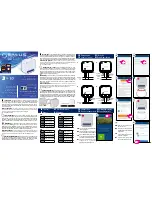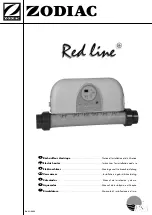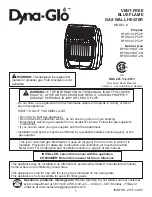
4. KEY LOCK
This function allows you to block the use of the keys. It may be useful to activate this
setting to avoid accidental changing of settings by unauthorised persons or children. To
activate it, hold down the [+] and [-] keys together for at least 3 seconds. A padlock icon
appears when the keys are locked, figure 4.
With the key lock active, it is still possible to put the thermostat in standby or in operation by pressing the [ON/Standby] button, but it is not possible to
change the temperature setting and the operating mode.
To deactivate the function, hold down the [+] and [-] keys together again for at least 3 seconds. The padlock icon disappears and the buttons resume
the normal functions.
For safety reasons, always prevent children playing with this product.
5. TIME SETTING AND FREE WEEKLY PROGRAMMING
Hold down the [ON/standby] and [Functions] buttons together for at least 3 seconds. The hour numbers will start to flash. Use [+] and [-] to set the
current hour and press the [Functions] button to confirm. Set the current minutes and day in the same way. The latter is indicated by a corresponding
point on the vertical numbered scale, figure 5.
After the time, proceed to the weekly programming. Set the sequence for each hour and for each day of the
week. The selection is made using the [+] and [-] keys; at that time [+] regulates the high temperature and [-] the
low temperature. On the time setting bar, a dash corresponds to the high temperature and the empty space
corresponds to the low temperature. Press the [Functions] button to save the day and start the next day with the
same procedure. For example, to have a high temperature from 6 to 10 a.m. and from 7 to 11 p.m. (and a low
temperature in the remaining intervals), see figure 6.
If the [ON/Standby] button is pressed when setting the time and the weekly programming, the electronic thermostat goes into standby status and the
new time/date setting is saved, while the new weekly programming is not saved. Pressing the [ON/Standby] button again brings the thermostat into the
present status before starting the procedure for setting the time.
If there is an interruption in the 230V ac power supply, the weekly programming made remains in the memory, along with the current mode (including
keyboard lock) and the high and low temperature settings, while the time must be reset. When the 230V ac power returns, if one of the chrono modes
is selected (free weekly programming P1, P2 or P3) the “Chrono” symbol flashes and the writing on the display (the current time or P1, P2 and P3
depending on the mode): in this case, follow the procedure illustrated at the start of the paragraph to reset the current time. Until the operation is
performed, the thermostat provisionally counts the time that passes from the moment the 230V ac power returns (and this “provisional” time is used if
one of the chrono modes is selected).
6. INTEGRATED WEEKLY PROGRAMMING
As well as the classic weekly programming defined by the user, the electronic thermostat has 3 integrated programs named respectively P1, P2 and
P3. To change from one to another, press the [Functions] button to select the desired mode as in figure 7.
Modes P1, P2 and P3 are fixed and are set as follows:
The programs P1, P2 and P3 are completely independent of one another and can only be used one at a time. If one of these is selected (for example
P3), the display appears as in figure 8.
The flashing dash (in grey in figure 8) indicated the time interval currently active.
If the user wants to use a weekly program other than P1, P2 or P3, he can make one with his own settings using the standard chrono program
illustrated in the previous paragraph.
Figure 5: Time and day of the week
Key Lock Icon
Figure 4: Key lock active
where:
= high temperature (“Comfort”);
= low temperature (“ECO”).
Figure 6: Free weekly
programming
Figure 7: Operating modes
selection order
Point indicating the day of the week
Numbered scale of the days of the week
Chrono operating mode icon
Time setting bar
Figure 8: Program P3 active.














































